The Brief
Produce and research an investigation of an ‘information’ format or behaviour. Present your exploration in an aesthetic form(s) that may be authentic (or derived from) the form, medium, structure and representations that help communicate your essay on your researched form(s) of information.
My Response
Summary
My report summarises a comparative assessment of the environmental impacts of paper books and electronic book readers. The conclusion reached is that a reader consuming an average number of books will do less damage to the environment if they use an e-book reader. I then provide a manifestation of the research intended to inform general audiences of the environmental impact of reading, and to make the book/e-book selection question easier for people to answer.
Introduction
Printed books
Early books were hand-written. Although printed texts have existed for well over a thousand years, this was very unusual and manual transcription continued until the 15th century CE.
The first known examples of text printed on paper are tiny, 2.5-inch-wide scrolls of Buddhist prayers commissioned by Japan’s Empress Shōtoku in 764 CE
Publisher, Author removed at request of original. 3.2 History of Books. Mar. 2016. open.lib.umn.edu, https://open.lib.umn.edu/mediaandculture/chapter/3-2-history-of-books/.
Early printed works, typically ecclesiastical in nature, were rare and very expensive. Over succeeding centuries, print took over from hand copying, however, it took the growing availability of paper, followed by the invention of mechanical, moveable type (commonly attributed to Johannes Gutenberg, although it appeared in China years before[1]The Song Dynasty in China | Asia for Educators. http://afe.easia.columbia.edu/songdynasty-module/tech-printing.html. Accessed 29 Aug. 2022.), to transform books into an industrial object.
The most dramatic shift came when Gutenberg, who had likely already produced earlier works, produced printed copies of the Bible in 1455.
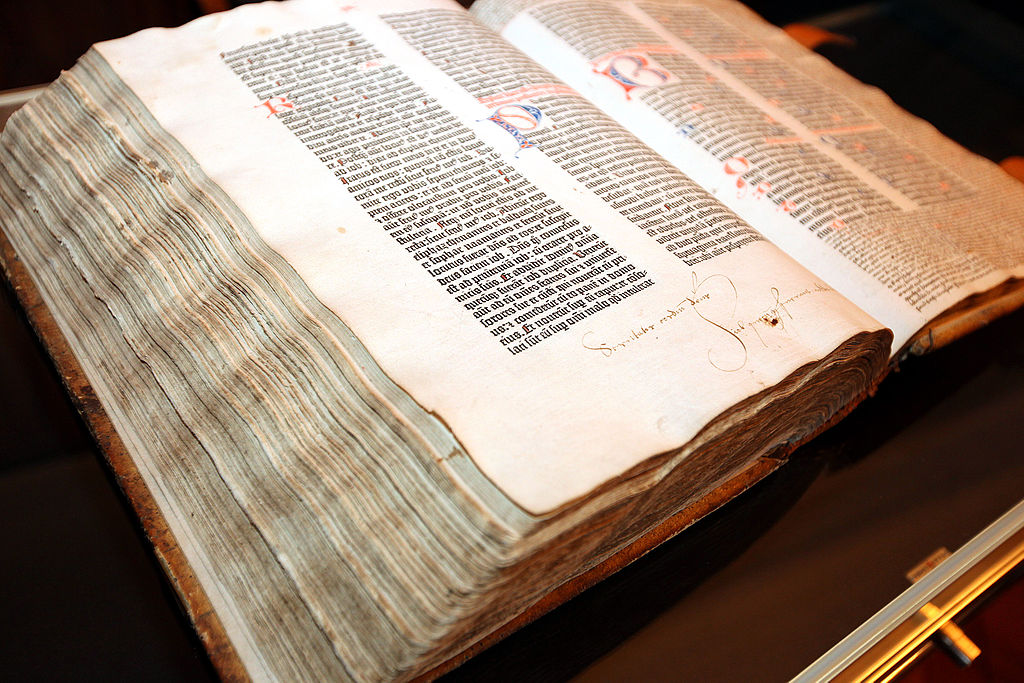
This brought about what’s commonly referred to as the “Gutenberg Revolution”, and in less than 50 years transformed books from expensive, closely held treasures into commodity items.
The Harry Ransom Humanities Research Center estimates that before the invention of the printing press, the total number of books in all of Europe was around 30,000. By 1500 CE, the book was thriving as an industrial object, and the number of books in Europe had grown to as many as 10 to 12 million (Jones, 2000).
Publisher, Author removed at request of original. 3.2 History of Books. Mar. 2016. open.lib.umn.edu, https://open.lib.umn.edu/mediaandculture/chapter/3-2-history-of-books/.
Electronic books
In the early 21st century, books became available for download in digital form, initially intended to be viewed on dedicated electronic devices called e-readers.
What is an e-reader?
E-readers differ from general purpose tablets, cellphones, and other similar devices. An e-reader is a dedicated electronic device for the display of digital versions of books and other written media, and featuring an electronic ink (e-ink) or other specialised display. Because of their e-ink displays, which can be read in bright light and only consume power when changing the page, e-readers are able to operate on very small amounts of power, and therefore require smaller batteries. This reduces e-readers’ environmental footprint dramatically compared to general purpose devices.
The first e-book reader that meets the definition above was the Sony Librie EBR 1000:
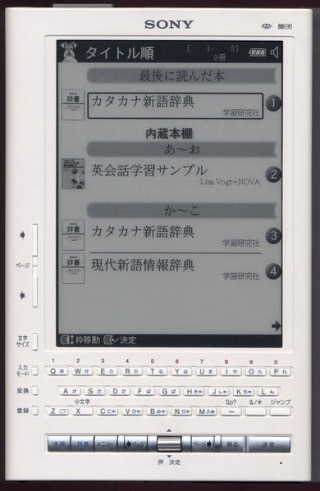
Released in 2004, it was arguably ahead of it’s time, and ultimately was a commercial failure. This was principally due to its unwieldy book download and sync software[2]I know this first hand – I own one that needed to run on a Microsoft Windows computer, and a proprietary e-book format that never caught on. The experience improved rapidly three years later, when Amazon launched their first Kindle e-reader with access to a wide variety of content from Amazon’s online Kindle book store.
Books and the environment
Both paper books and e-books and their readers have an environmental impact. It’s widely believed that e-books and e-readers are better for the environment than paper books, but is that actually the case?
When and how is the environmental affected?
I found a number of research studies and papers that addressed the environmental impacts of e-books, e-readers, and paper books, but none that also included data transfer and storage, and none that were holistic in developing a like-for-like model.
I chose to develop an e-reader/e-book and paper book, “cradle to grave” environmental assessment. The assessment will be over 100 books, given that users of e-readers typically read 35 books per year, and the nominal life of an e-reader is typically 3-5 years. The factors considered include:
- materials
- water
- manufacture
- energy
- water
- other impacts
- transport
- fuel
- data transport for e-books
- use by a consumer
- power
- disposal
- recycle options
- waste
1. Materials
There is a significant difference between the materials used for each type of book. Paper books typically use wood pulp, whereas e-readers are electronic devices, so use a variety of naturally occurring minerals, as well as man-made chemicals.
Paper book
A single metric tonne of paper requires around 17 trees – an average of 59 kilos of paper per tree. If we assume that an average 400-page paperback weighs about 600 grams, one tree can spawn just under 100 books.
‘E-Readers vs Books: Which Are Better for the Environment? ♻CW’. Commercial Waste, 31 May 2022, https://commercialwaste.trade/e-readers-vs-books-better-environment/.
As well as wood pulp, paper books also require mineral extraction, although the amounts are relatively small and are typically the innocuous gravel used for forestry road surfaces.
E-reader
An e-reader requires approximately 15kg of minerals [3]Op-Chart – How Green Is My IPad? – NYTimes.Com. https://archive.nytimes.com/www.nytimes.com/interactive/2010/04/04/opinion/04opchart.html. Accessed 29 Aug. 2022..
The minerals used are extremely diverse, and sadly can include trace elements only extracted in conflict regions. Please see below for a brief digression on “conflict minerals”. Recycling can help, and many electronics manufacturers are actively working on this.
2. Manufacture
Paper book
Research shows that CO2 emissions per kilo of book varies widely, depending on the book. On average this is 0.3kg per book.
Paper books also use significant amounts of water in their production.
The US benchmark for water use within pulp and paper mills is approximately 17,000 gallons/ton of paper, with one of the most efficient kraft pulp and paper mills only using 4,500 gallons/ton.
Ryberg, Alaina. MnTAP – Water Use. http://www.mntap.umn.edu/industries/facility/paper/water/. Accessed 29 Aug. 2022.
E-reader
The manufacture of an e-reader, as with other electronic devices, uses considerable amounts of energy. For a typical e-reader this is around 100 kilowatt hours of energy.
An e-reader also requires 350 lites of water for its production [4]Op-Chart – How Green Is My IPad? – NYTimes.Com. https://archive.nytimes.com/www.nytimes.com/interactive/2010/04/04/opinion/04opchart.html. Accessed 29 Aug. 2022..
Overall, this produces around 30kg of CO2 per device.
Like any consumer electronic, e-readers are generally energy- and water-intensive. It’s difficult to nail down the exact amount of energy consumed in producing an e-reader from all its component parts, and the international supply chain only complicates the process further, says Dunn. It is estimated that producing one e-reader uses around 100 kilowatt hours of fossil fuels and 79 gallons of water, and also emits 66 pounds of carbon dioxide.
‘You May Need to Read Dozens of Books Each Year to Offset That New E-Reader’. Popular Science, 17 Feb. 2022, https://www.popsci.com/environment/books-ereader-sustainability/.
3. Transport
Paper book
This is perhaps the most significant differentiator between paper and e-books. Paper books need to be physically delivered to their readers. This is typically done through an as-yet unreformed transport network that makes heavy use of fossil fuels. This situation is improving, but we are some decades away from a sustainable transport sector.
If you order a book online and have it shipped 500 miles by air, that creates roughly the same pollution and waste as making the book in the first place.
Op-Chart – How Green Is My IPad? – NYTimes.Com. https://archive.nytimes.com/www.nytimes.com/interactive/2010/04/04/opinion/04opchart.html. Accessed 29 Aug. 2022.
Another issue with paper books is that many go unsold and are returned to publishers.
Meanwhile 25 to 36 percent of all books in bookstores are returned to the publisher, wasting tremendous amounts of energy in transportation and disposal.
‘You May Need to Read Dozens of Books Each Year to Offset That New E-Reader’. Popular Science, 17 Feb. 2022, https://www.popsci.com/environment/books-ereader-sustainability/.
E-reader/E-book
I will include data storage and transport in this section.
E-reader
Most electronic devices are made in China or other Asian countries. There is an environmental cost to transporting the device to a local distribution centre, and then a cost to either ship the device out to a customer, or for a customer to drive to a store to buy the device.
I will assume that a cost associated with delivering the e-reader to the consumer is approximately double that of transporting a paper book (to allow for increased distances in early stage transport).
E-book
E-books themselves are at a significant advantage over paper books, because the storage and data transmission costs of an e-book produces few emissions.
The average data size of an e-book is 2.6MB[5]https://eliteauthors.com/blog/the-average-size-of-a-kindle-e-book/.
I found a 2012 article on carbon emissions from data centres.
Data usage on the internet is estimated to be 20,151 PetaBytes per month (Cisco 2011). This is equivalent to 241 billion GB per year. Applying these figures to the average power estimate yields a figure of 5.12 kWh per GB.
Costenaro, David, and Anthony Duer. ‘The Megawatts behind Your Megabytes: Going from Data-Center to Desktop’. Undefined, 2012. www.semanticscholar.org, https://www.semanticscholar.org/paper/The-Megawatts-behind-Your-Megabytes%3A-Going-from-to-Costenaro-Duer/e1128ae4c753b41a27b8a25a906cf3ac44d9cb5d.
A recent paper attempted to estimate the costs of producing web content, which is analogous to digitally delivered e-book content.
…the average US power plant expends 600 grams of carbon dioxide for every kWh generated.
Pscheid, Julian. Does Irresponsible Web Development Contribute to Global Warming? Emerge Interactive, June 2020, https://www.emergeinteractive.com/insights/detail/does-irresponsible-web-development-contribute-to-global-warming/.
Although the author originally cited older US Department of Energy data[6]https://www.emergeinteractive.com/wp-content/uploads/2020/02/DOE-CO2-Emissions-Generation-Electric-Power-2000.pdf, he later revisited his article to update his statistics.
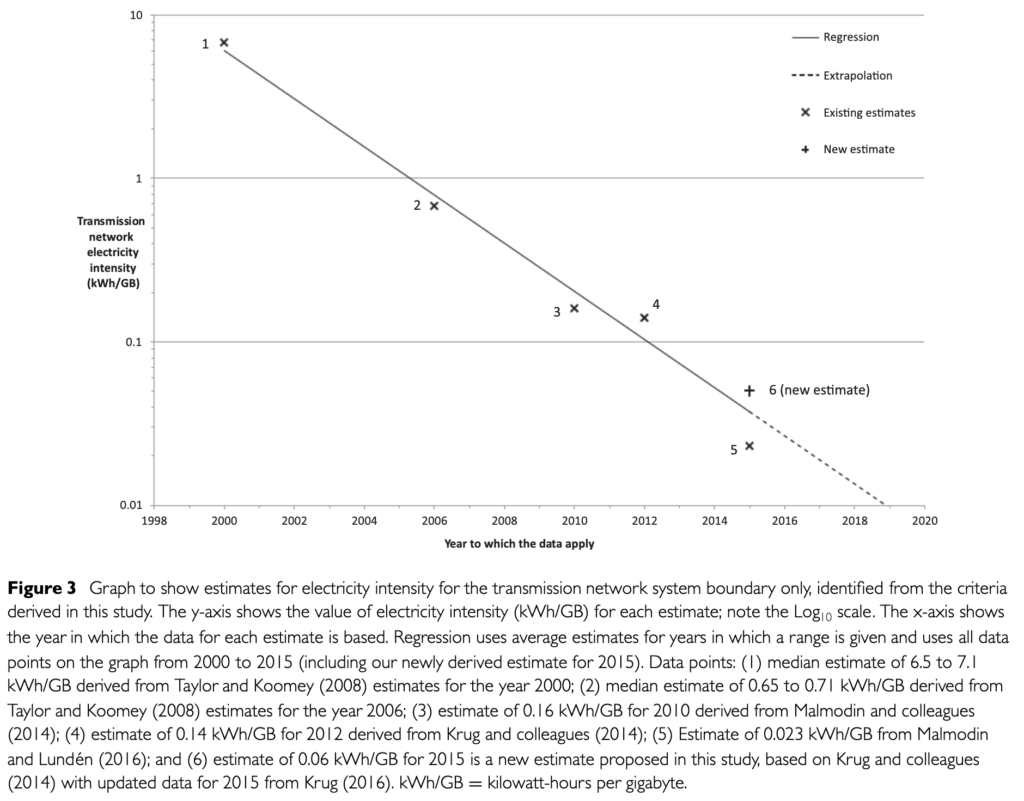
In summary, the author estimates that transferring 1GB of data produces 3kg of CO2.
With an estimated 260MB for my 100 book example, this means that the data transfer of the 100 e-books would generate approximately 750g of CO2.
4. Use by a consumer
Paper book
In daylight, zero energy is used.
E-book
As paper books and e-readers are both readable in daylight, and both require equal illumination to read at night, I will discount this aspect from the energy calculation. This means that only e-readers require energy to operate.
Charging an e-reader takes very little energy. Their screens are highly energy efficient, and the computing power needed is very low.
E-readers are useable for multiple years.
Even after an e-reader is produced, the device requires energy since it has to be charged over and over again. On the assumption that an e-reader will last a decade, it can use up about 194 megajoules of energy in its lifetime. For context, a petrol car uses about 142 megajoules per 100 kilometers.
‘You May Need to Read Dozens of Books Each Year to Offset That New E-Reader’. Popular Science, 17 Feb. 2022, https://www.popsci.com/environment/books-ereader-sustainability/.
Although it is difficult to extrapolate the energy required to read 100 books, I estimate that reading 100 typical e-books will produce 1kg of CO2.
5. Disposal / Recycling
Paper book
Disposing of paper, typically for recycling, is a well-established capability in most countries. However, it should be noted that this depends on the type of book. Standard paperbacks can be pulped, whereas glossy-paged, hardcover books may not be so easy to deal with.
E-reader
Many of the components in an e-reader can be recycled, but in reality a lot of this is attempted by hand in developing countries. The workers may be exposed to toxic chemicals, and only partial material recovery may occur.
Worse, e-readers may simply go into landfill, where their toxins leach into the environment over may years. The amount of toxic material though, compared to a device like a cellphone or general purpose tablet, is very low.
Manifestation of research: Infographic
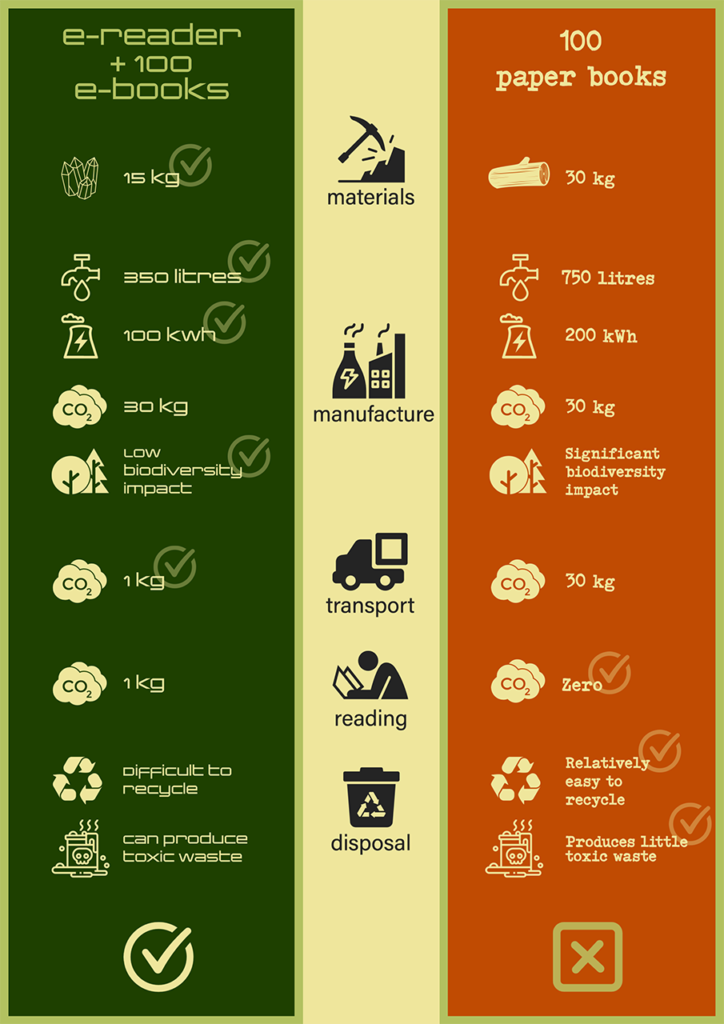
Recommendations
- Use your local library. Ideally, walk there. This is the “gold standard” for environmentally friendly reading.
- Next choice, buy secondhand books. Keep what you love; sell the rest. Again, this is a good environmental choice.
- If you read more than 30 books a year, consider a dedicated e-reader. Your local library will often have free content.
- If you have an e-reader, looks after it and use it for as long as possible – don’t upgrade unless you are forced to.
- Recycle your e-reader with care – always verify how this will happen. Do not put an e-reader in the bin unless you’re sure it will be recycled. Seek out free e-waste recycling options, but do read the “small print”. Does the recycling happen in developing countries?
Taking this work further
Additional research beyond this assignment
In the time available, I did not fully complete my research, and other avenues opened up that I would have liked to explore. One critical one is the increased environmental damage from general purpose tablets over e-readers. Apple’s own figures show that an iPad produces approximately four times the amount of CO2 equivalent over its lifecycle than a e-reader, 95% of which happens before a user first turns it on. One could argue that this is offset by the iPad being a general purpose device.
I would have also liked to look further into recycling and disposal. This should be of great concern in New Zealand, as our capability as a country to recycle electronics is very limited.
The future
Sales of e-books are still rising:
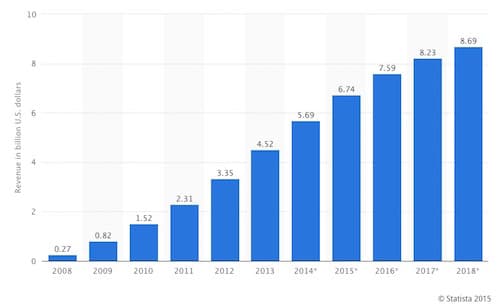
However, e-readers themselves have been through a boom/bust cycle, and sadly sales are now in rapid decline:
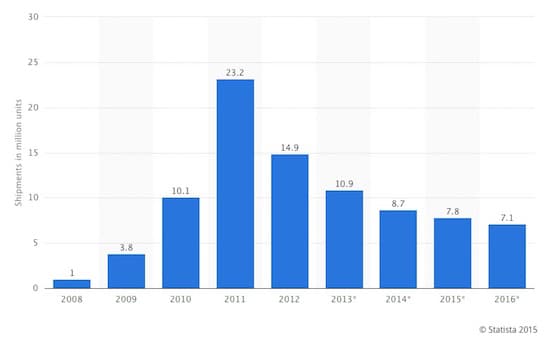
This is in the main due to the rapid rise of tablet sales, which are now widely used to read e-books.
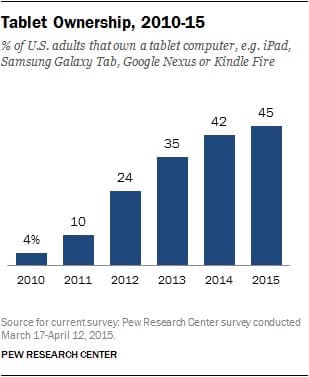
I do not have time or space to show in detail that this is bad environmental news. Suffice to say that a general purpose tablet with a high resolution backlit screen, fast processor, and large battery, consumes far more resources than e-reader. They are also harder to recycle.
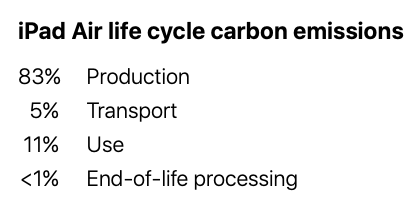
Data traffic online also grows, although the majority of data growth is obviously not e-books given the volumes involved.
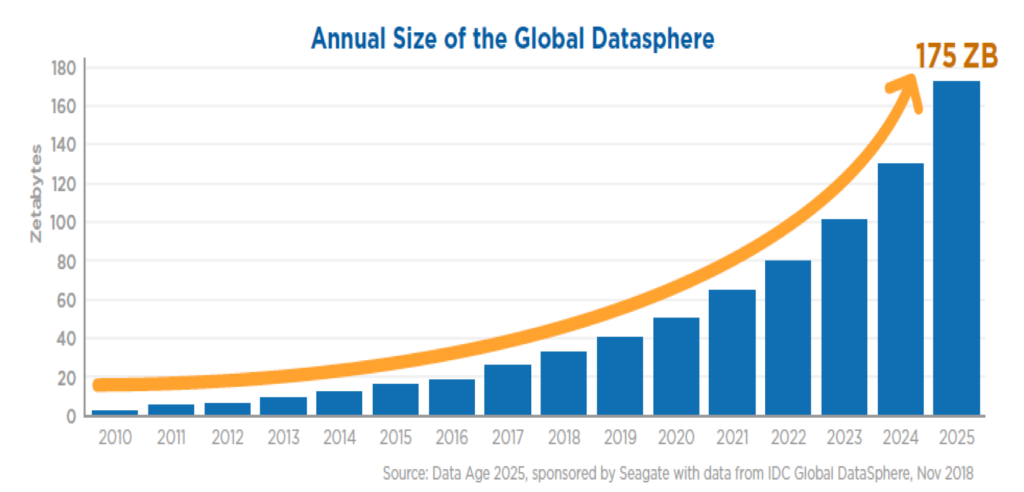
The use of renewable energy sources is also growing, as is the use of electric vehicles, although the freight industry is still not really benefitting from this. That should benefit both paper and e-books, but given the slow speed of uptake of freight services using electricity or other renewable energy sources, e-books benefit more. One e-reader can host many thousands of books and only needs to be shipped once.
Other environmental effects
Biodiversity loss
Planting managed forests – typically a monoculture – has been noted as reducing biodiversity.
There are various certification systems that connect corporate buyers to responsibly sourced paper. Publishers all over the globe are striving to move to certified paper. These systems, like the Forest Stewardship Council (FSC), have their drawbacks. However, as pointed out by the Rainforest Action Network, establishing comprehensive and rigorous processes that make the paper supply chain transparent, and using verification tools like fiber testing, can go a long way to ensure that the paper used by a company has been responsibly sourced.
Patra, Senjuti. ‘The Cost of Reading: The Book Industry’s Carbon Footprint’. BOOK RIOT, 10 Feb. 2022, https://bookriot.com/carbon-footprint-of-publishing/.
Conflict minerals
What are they?
All tablets contain the 3TGs (tin, tantalum, tungsten and gold), minerals that are largely found in the Democratic Republic of Congo (DRC) and surrounding countries. Profits from the sale of these minerals are the most significant financier of the armed conflicts that have plagued the country since the 1990s. This has made control of the mines that produce them an important military objective in itself.
‘Tablets and E-Readers’. Ethical Consumer, 17 Apr. 2018, https://www.ethicalconsumer.org/technology/shopping-guide/tablets-e-readers.
Paper books don’t contain conflict minerals, although of course computers and other electronics are used in the creation and publishing of books, but this use is amortised over enough books to be rendered negligible at the single unit level.
Other references
- Naicker, Vinesh, and Brett Cohen. ‘A Life Cycle Assessment of E-Books and Printed Books in South Africa’. Journal of Energy in Southern Africa, vol. 27, no. 2, May 2016, pp. 68–77. SciELO, http://www.scielo.org.za/scielo.php?script=sci_abstract&pid=S1021-447X2016000200007&lng=en&nrm=iso&tlng=en.
References
| ↑1 | The Song Dynasty in China | Asia for Educators. http://afe.easia.columbia.edu/songdynasty-module/tech-printing.html. Accessed 29 Aug. 2022. |
|---|---|
| ↑2 | I know this first hand – I own one |
| ↑3, ↑4 | Op-Chart – How Green Is My IPad? – NYTimes.Com. https://archive.nytimes.com/www.nytimes.com/interactive/2010/04/04/opinion/04opchart.html. Accessed 29 Aug. 2022. |
| ↑5 | https://eliteauthors.com/blog/the-average-size-of-a-kindle-e-book/ |
| ↑6 | https://www.emergeinteractive.com/wp-content/uploads/2020/02/DOE-CO2-Emissions-Generation-Electric-Power-2000.pdf |
